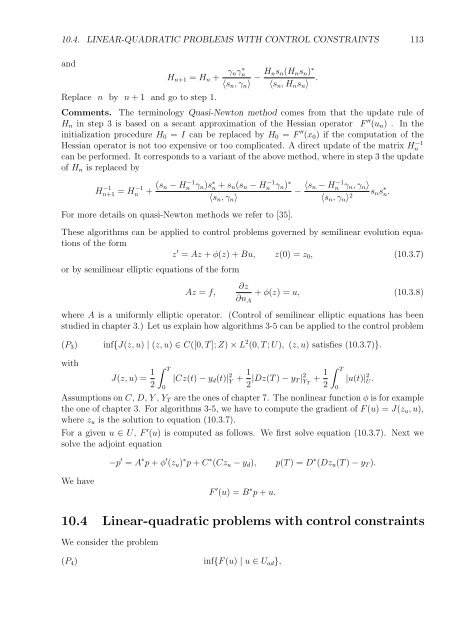Optimal Control of Partial Differential Equations
Optimal Control of Partial Differential Equations
Optimal Control of Partial Differential Equations
Create successful ePaper yourself
Turn your PDF publications into a flip-book with our unique Google optimized e-Paper software.
10.4. LINEAR-QUADRATIC PROBLEMS WITH CONTROL CONSTRAINTS 113<br />
and<br />
Replace n by n + 1 and go to step 1.<br />
Hn+1 = Hn + γnγ∗ ∗<br />
n Hnsn(Hnsn)<br />
−<br />
〈sn, γn〉 〈sn, Hnsn〉 .<br />
Comments. The terminology Quasi-Newton method comes from that the update rule <strong>of</strong><br />
Hn in step 3 is based on a secant approximation <strong>of</strong> the Hessian operator F ′′ (un) . In the<br />
initialization procedure H0 = I can be replaced by H0 = F ′′ (x0) if the computation <strong>of</strong> the<br />
Hessian operator is not too expensive or too complicated. A direct update <strong>of</strong> the matrix H−1 n<br />
can be performed. It corresponds to a variant <strong>of</strong> the above method, where in step 3 the update<br />
<strong>of</strong> Hn is replaced by<br />
H −1<br />
n+1 = H −1<br />
n + (sn − H−1 n γn)s∗ n + sn(sn − H−1 n γn) ∗<br />
〈sn, γn〉<br />
For more details on quasi-Newton methods we refer to [35].<br />
− 〈sn − H−1 n γn, γn〉<br />
〈sn, γn〉 2 sns ∗ n.<br />
These algorithms can be applied to control problems governed by semilinear evolution equations<br />
<strong>of</strong> the form<br />
z ′ = Az + φ(z) + Bu, z(0) = z0, (10.3.7)<br />
or by semilinear elliptic equations <strong>of</strong> the form<br />
Az = f,<br />
∂z<br />
+ φ(z) = u, (10.3.8)<br />
∂nA<br />
where A is a uniformly elliptic operator. (<strong>Control</strong> <strong>of</strong> semilinear elliptic equations has been<br />
studied in chapter 3.) Let us explain how algorithms 3-5 can be applied to the control problem<br />
(P3) inf{J(z, u) | (z, u) ∈ C([0, T ]; Z) × L 2 (0, T ; U), (z, u) satisfies (10.3.7)}.<br />
with<br />
J(z, u) = 1<br />
T<br />
|Cz(t) − yd(t)|<br />
2 0<br />
2 Y + 1<br />
2 |Dz(T ) − yT | 2 YT<br />
T<br />
1<br />
+ |u(t)|<br />
2 0<br />
2 U.<br />
Assumptions on C, D, Y , YT are the ones <strong>of</strong> chapter 7. The nonlinear function φ is for example<br />
the one <strong>of</strong> chapter 3. For algorithms 3-5, we have to compute the gradient <strong>of</strong> F (u) = J(zu, u),<br />
where zu is the solution to equation (10.3.7).<br />
For a given u ∈ U, F ′ (u) is computed as follows. We first solve equation (10.3.7). Next we<br />
solve the adjoint equation<br />
We have<br />
−p ′ = A ∗ p + φ ′ (zu) ∗ p + C ∗ (Czu − yd), p(T ) = D ∗ (Dzu(T ) − yT ).<br />
F ′ (u) = B ∗ p + u.<br />
10.4 Linear-quadratic problems with control constraints<br />
We consider the problem<br />
(P4) inf{F (u) | u ∈ Uad},

















